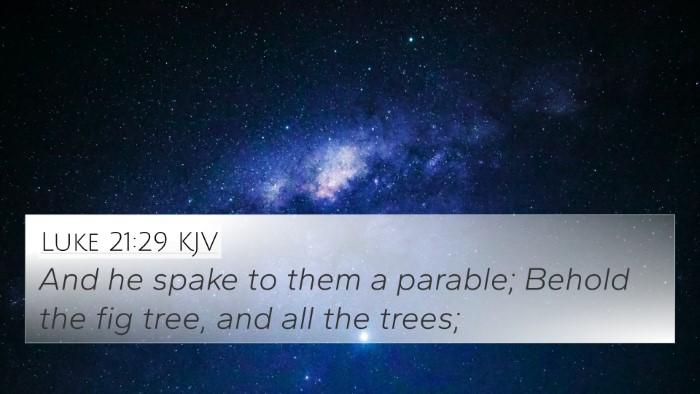Understanding Mark 13:28
Verse: "Now learn this parable from the fig tree: When its branch has already become tender and puts forth leaves, you know that summer is near."
Summary of Insights
This verse from the Gospel of Mark illustrates a significant teaching of Jesus regarding the signs of the times and the coming kingdom of God. By using the fig tree as a metaphor, Jesus emphasizes the importance of discernment in recognizing the spiritual truths that signal the arrival of significant events, particularly in relation to His second coming.
Commentary Highlights
-
Matthew Henry:
Matthew Henry emphasizes that the fig tree's tender branches and leaves indicate the change of seasons. This parable serves as a reminder to believers to be observant of the signs around them, paralleling the spiritual awakening that precedes Christ's return.
-
Albert Barnes:
Barnes notes that the fig tree has practical implications for the disciples. Just as physical changes in nature alert us to seasons, spiritual indicators in the world should alert believers to the nearness of Christ’s return. The clear signs prompt vigilance and preparedness.
-
Adam Clarke:
Clarke interprets the fig tree as a sign of the impending fulfillment of prophecies. The parable indicates that when certain events occur, especially those surrounding calamities and moral decay, it’s time for vigilance in faith and expectation.
Key Themes in Mark 13:28
- Awareness of Signs: Just as one observes a fig tree, believers need to be aware of the indicators of divine timing.
- Spiritual Readiness: The emphasis on preparation reflects the need for believers to remain steadfast in faith, ready for Christ’s return.
- Relationship between Nature and Prophecy: This verse symbolizes the connection between the natural world and prophetic events—the physical realm conveying spiritual truths.
Cross-References to Mark 13:28
Below are some related Bible verses that enhance understanding of Mark 13:28 through thematic connections and cross-references:
- Matthew 24:32-33: Similar teaching about recognizing the signs of the end times through the fig tree.
- Luke 21:29-31: Reinforces the lesson of understanding the times through observation of events.
- James 5:7: Encourages patience in waiting for the Lord, likening it to farmers waiting for harvest.
- Romans 13:11: Urges believers to wake from sleep, acknowledging the urgency of the time.
- 1 Thessalonians 5:2: Reiterates the certainty of the day of the Lord coming unexpectedly.
- 2 Peter 3:10-12: Discusses the coming of the Lord and the significance of living holy lives in light of His return.
- Hebrews 10:25: Stresses the importance of not neglecting to gather and encourage one another, especially as the day approaches.
- Revelation 22:12: Jesus indicates His imminent return and the reward for those who remain vigilant.
Conclusion
In conclusion, Mark 13:28 serves as a vital reminder for believers to be alert and discerning in the face of worldly events that reflect divine truths. This verse is rich with implications about spiritual vigilance, readiness, and the interconnectedness of prophecy and everyday life. By studying connections between Bible verses and utilizing tools for Bible cross-referencing, believers can deepen their understanding of this essential teaching.
Further Study and Resources
For those interested in exploring more about Bible verses that relate to each other, various resources can assist in understanding these connections:
- Bible Concordance: A tool for locating verses that contain similar themes or keywords.
- Cross-Reference Bible Study: A method used for examining related scriptures that illuminate the same truths.
- Comprehensive Bible Cross-Reference Materials: These can provide extensive networks of related verses.
- Tools for Bible Cross-Referencing: Guides and literature that explore thematic connections among Biblical texts.
Utilizing these resources will enrich your study and help cultivate a deeper engagement with the teachings of Scripture.




